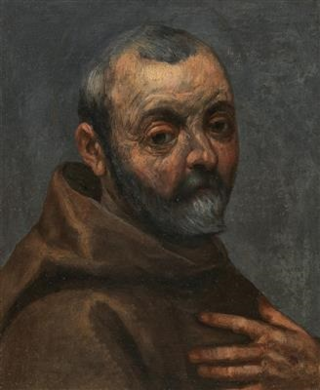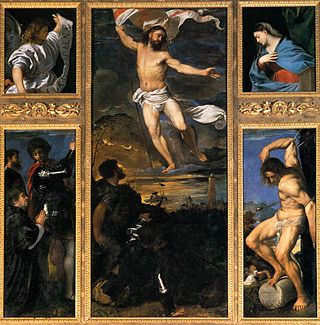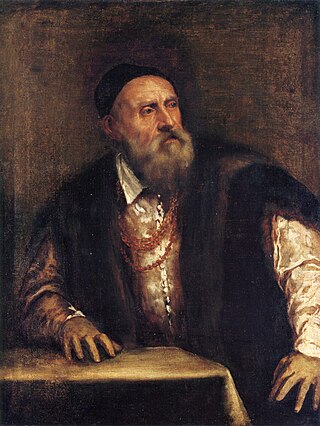
Paolo Caliari, known as Paolo Veronese, was an Italian Renaissance painter based in Venice, known for extremely large history paintings of religion and mythology, such as The Wedding at Cana (1563) and The Feast in the House of Levi (1573). Included with Titian, a generation older, and Tintoretto, a decade senior, Veronese is one of the "great trio that dominated Venetian painting of the cinquecento" and the Late Renaissance in the 16th century. Known as a supreme colorist, and after an early period with Mannerism, Paolo Veronese developed a naturalist style of painting, influenced by Titian.

Lorenzo Lotto was an Italian painter, draughtsman, and illustrator, traditionally placed in the Venetian school, though much of his career was spent in other north Italian cities. He painted mainly altarpieces, religious subjects and portraits. He was active during the High Renaissance and the first half of the Mannerist period, but his work maintained a generally similar High Renaissance style throughout his career, although his nervous and eccentric posings and distortions represented a transitional stage to the Florentine and Roman Mannerists.

The Basilica di Santa Maria Gloriosa dei Frari, commonly abbreviated to the Frari, is a church located in the Campo dei Frari at the heart of the San Polo district of Venice, Italy. It is the largest church in the city and it has the status of a minor basilica. The church is dedicated to the Assumption of Mary.

The Chiesa di San Giacomo dall'Orio is a church located in the sestiere (quarter) of Santa Croce in Venice, northern Italy.

Roch, also called Rock in English, was a Majorcan Catholic confessor whose death is commemorated on 16 August and 9 September in Italy; he was especially invoked against the plague. He has the designation of Rollox in Glasgow, Scotland, said to be a corruption of Roch's Loch, which referred to a small loch once near a chapel dedicated to Roch in 1506.

The Martyrdom of Saint Matthew is a painting by the Italian master Michelangelo Merisi da Caravaggio. It is located in the Contarelli Chapel of the church of the French congregation San Luigi dei Francesi in Rome, where it hangs opposite The Calling of Saint Matthew and beside the altarpiece The Inspiration of Saint Matthew, both by Caravaggio. It was the first of the three to be installed in the chapel, in July 1600.

The Madonna and Child with St. Anne or Madonna and the Serpent, is one of the mature religious works of the Italian Baroque master Caravaggio, painted in 1605–1606, for the altar of the Archconfraternity of the Papal Grooms in the Basilica of Saint Peter and taking its theme from Genesis 3:15. The painting was briefly exhibited in the parish church for the Vatican, Sant'Anna dei Palafrenieri, before its removal, due to its unorthodox portrayal of the Virgin Mary. There are a lot of reasons why the piece may have been removed, such as the nudity of the child Jesus and the Virgin Mary revealing too much of her breast. The reputation of the model that Caravaggio used to portray the Virgin Mary could be another reason as to why this altarpiece was withdrawn. The altarpiece was sold to Cardinal Scipione Borghese and now hangs in his palazzo.

Iacopo Negretti, best known as Jacopo or Giacomo Palma il Giovane or simply Palma Giovane, was an Italian painter from Venice and a notable exponent of the Venetian school.

The Pietà is one of the last paintings by the Italian master Titian, and in its final, extended state was left incomplete at his death in 1576, to be completed by Palma Giovane. Titian had intended it to hang over his grave, and the two stages of painting were to make it fit in two different churches. It is now in the Gallerie dell'Accademia in Venice.

The Assumption of the Virgin or Frari Assumption, popularly known as the Assunta, is a large altarpiece panel painting in oils by the Italian Renaissance artist Titian, painted in 1515–1518. It remains in the position it was designed for, on the high altar of the Basilica di Santa Maria Gloriosa dei Frari or Frari church in Venice. It is the largest altarpiece in the city, with the figures well over life-size, necessitated by the large church, with a considerable distance between the altar and the congregation. The images above and below are not Titian's work, they are by Palma Vecchio. It marked a new direction in Titian's style, that reflected his awareness of the developments in High Renaissance painting further south, in Florence and Rome, by artists including Raphael and Michelangelo. The agitated figures of the Apostles marked a break with the usual meditative stillness of saints in Venetian painting, in the tradition of Giovanni Bellini and others.

The Feast in the House of Levi or Christ in the House of Levi is a 1573 oil painting by Italian painter Paolo Veronese and one of the largest canvases of the 16th century, measuring 560 cm × 1,309 cm. It is now in the Gallerie dell'Accademia in Venice. It was painted by Veronese for a wall of a Dominican friary called the refectory of the Basilica di Santi Giovanni e Paolo.

The Crucifixion is a life sized painting by the Venetian artist Titian, completed in 1558 and presently hanging in the sanctuary of the church of San Domenico, Ancona. Jesus Christ is shown crucified, with Saint Mary and Saint John standing either side of the cross in the Stabat Mater tradition. The kneeling figure is of Saint Dominic. The canvas was completed during Titian's fifth decade of painting, and is one of the works marking a shift toward his extensive exploration of tragedy and human suffering.

The Flaying of Marsyas is a painting by the Italian late Renaissance artist Titian, probably painted between about 1570 and his death in 1576, when in his eighties. It is now in the Archbishop's Palace in Kroměříž, Czech Republic and belongs to the Archbishopric of Olomouc. It is one of Titian's last works, and may be unfinished, although there is a partial signature on the stone in the foreground.

The church of Santa Maria Assunta, known as I Gesuiti, is a religious building in Venice, Italy. It is located in the sestiere of Cannaregio, in Campo dei Gesuiti, not far from the Fondamenta Nuove.

The Averoldi Polyptych, also known as the Averoldi Altarpiece, is a painting by the Italian Renaissance painter Titian, dating to 1520–1522, in the basilica church of Santi Nazaro e Celso in Brescia, northern Italy.

The Three Ages of Man is a painting by Titian, dated between 1512 and 1514, and now displayed at the Scottish National Gallery in Edinburgh. The 90 cm high by 151 cm wide Renaissance art work was most likely influenced by Giorgione's themes and motifs of landscapes and nude figures—Titian was known to have completed some of Giorgione's unfinished works after Giorgione died at age 33 of the plague in 1510. The painting represents the artist's conception of the life cycle. Childhood and manhood are synonymous with earthly love and death. These and the approaching old age are drawn realistically. Titian's widely chosen topic in art history, ages of man, mixed with his own allegorical interpretation make The Three Ages of Man one of Titian's most famous works.

Self-Portrait is an oil on canvas self-portrait by the Venetian painter Titian, dated c. 1546–47. While he painted a number of independent self-portraits in various formats, this is one of only two painted examples to survive. The other is in Madrid, dated c. 1560. Both share a somber and reserved palette, although this example is richer in tonal variation and colour harmonisation.

The Adoration of the Magi by the Venetian artist Paolo Veronese is a large oil painting on canvas dated to 1573 which has been in the National Gallery, London since 1855, shortly after it was sold by the Venetian church for which it was commissioned. It shows the common subject in the Nativity art of the visit by the Three Kings to the infant Jesus, here given a grandly theatrical treatment typical of Veronese's mature works. It was not an altarpiece, having been painted to hang beside rather than over a side altar in the nave of the church.

Venus and Cupid (Sleeping Venus) is a circa 1626 painting by Artemisia Gentileschi in the Virginia Museum of Fine Arts. Venus and Cupid is a depiction of a sleeping Venus, who reclines on a blue bed covering and rich crimson and gold tasseled pillow. She wears nothing except a thin wisp of transparent linen around her thigh. Her son Cupid fans her with richly colored peacock feathers as she drifts to sleep. He is gazing at her with an adored, raptured expression. In the background, there is a window looking out onto a moonlight landscape where a temple to the goddess lies. Venus's face has full cheeks, heavy lids, a prominent nose, and small protruding chin—all features of Gentileschi's own face. The body movements are natural: Venus's hand rests lightly on her side, her legs are gently laid together. The work blends together realism and classicism through its iconography and the artist's style.
Save Venice Inc. is a U.S. non-profit organization dedicated to the conservation of art and architecture and the preservation of cultural heritage sites in Venice, Italy. Headquartered in New York City, it has an office in Venice, a chapter in Boston, and supporters across the United States and Europe.



















